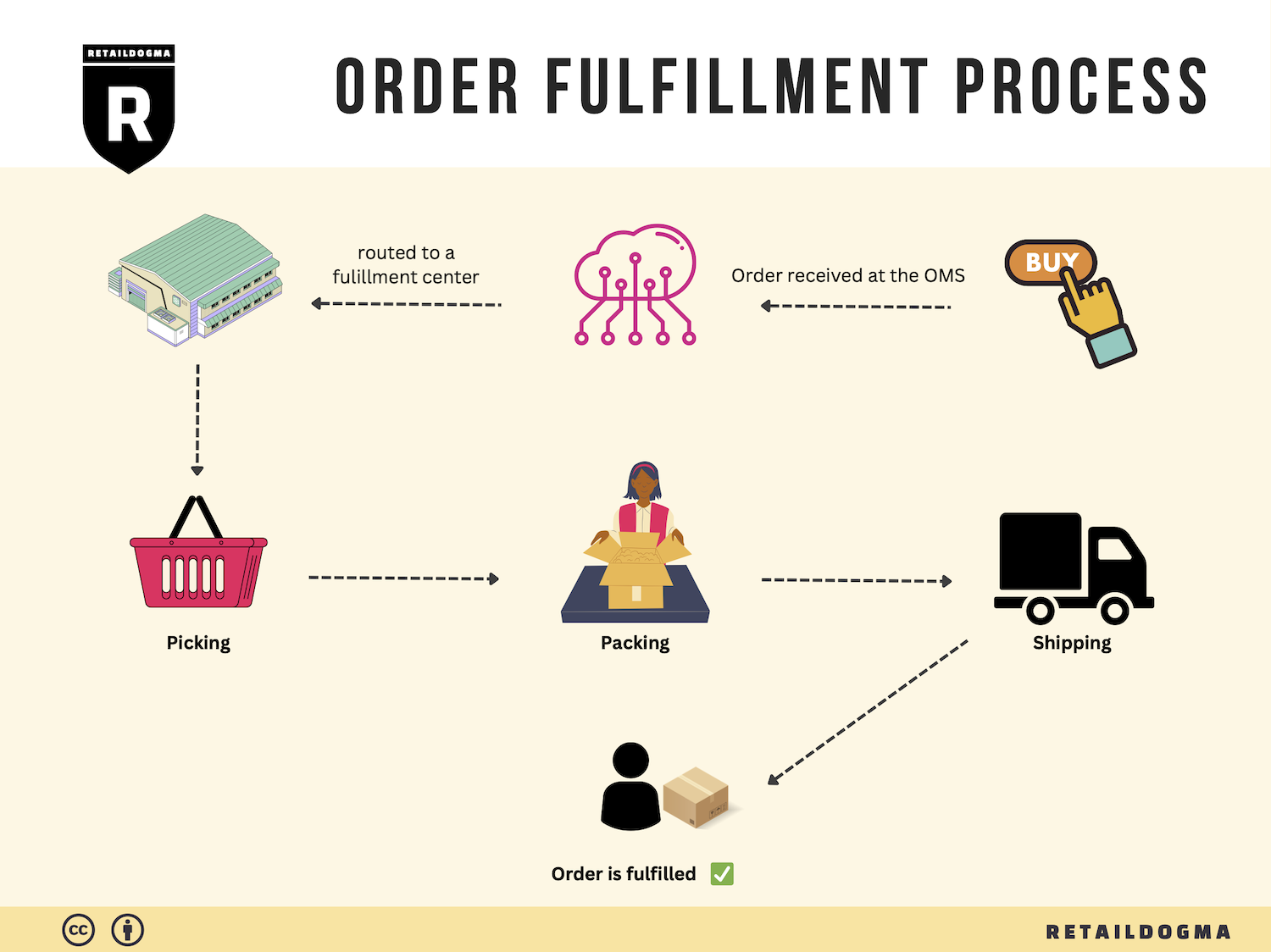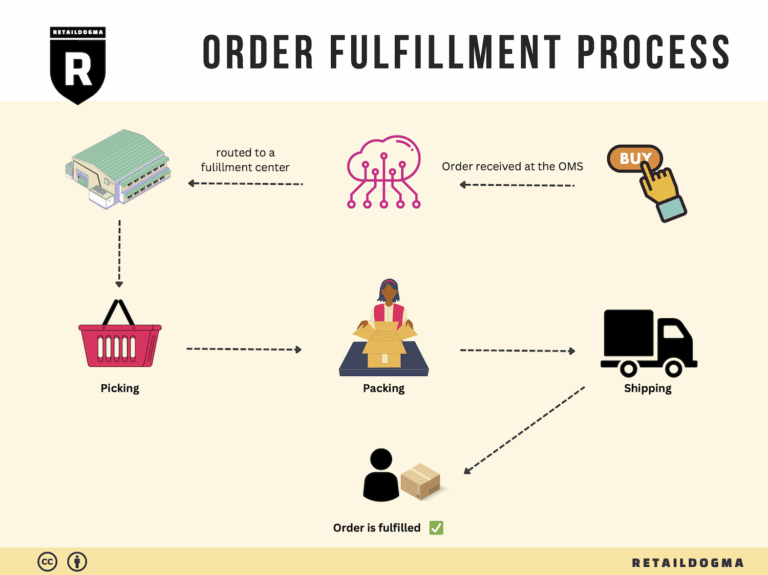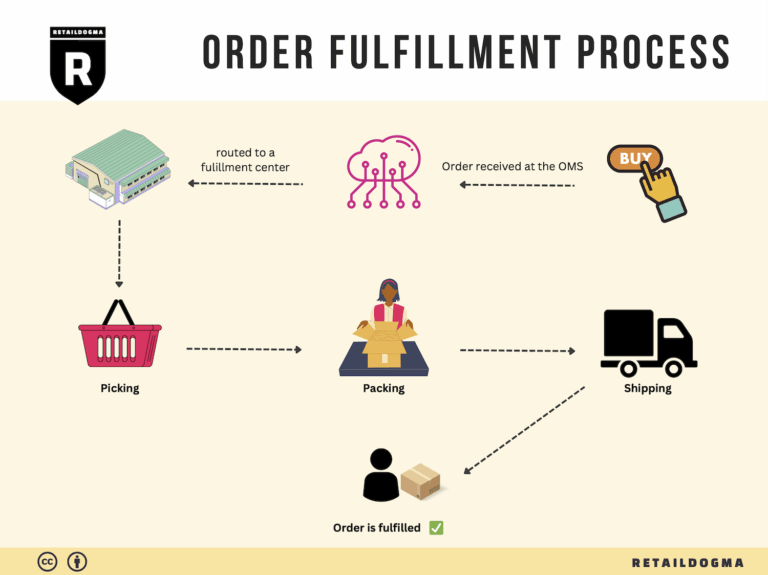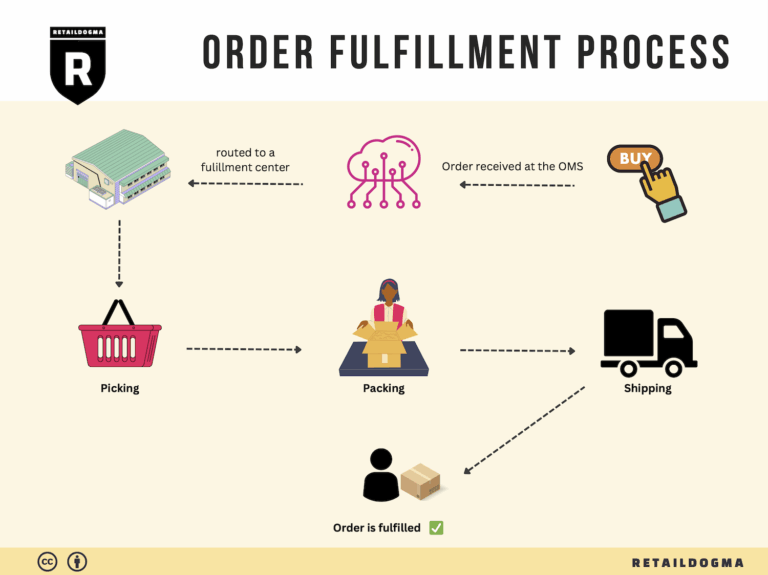How Order Fulfillment Works: A Step-by-Step Guide for Businesses
What is E-commerce Fulfillment? An Introduction for Growing Businesses
Introduction to E-commerce Fulfillment
As an online business grows, one of the most common pain points is the overwhelming burden of packing and shipping orders. Many entrepreneurs find themselves drowning in logistics, spending countless hours managing inventory, packing boxes, and coordinating shipments, which diverts their focus from growing their business. This is where understanding e-commerce fulfillment becomes crucial.
At its core, fulfillment is the process of getting a product from your inventory to your customer’s doorstep. It encompasses various steps, including inventory management, order processing, packing, shipping, and handling returns. As your sales increase, so does the complexity of these operations. That’s why it’s vital to have a clear strategy and a reliable fulfillment partner.
This guide aims to demystify e-commerce fulfillment by exploring different fulfillment models that can accommodate your growing business needs. We’ll delve into the most popular options, such as third-party logistics (3PL) providers and Fulfillment by Amazon (FBA), each offering unique benefits tailored to different business models. Understanding these options will empower you to make informed choices about how to manage your logistics effectively.
Additionally, we will outline the core services typically offered by fulfillment partners, such as inventory storage, order picking and packing, shipping management, and returns processing. Knowing what services are available can help you identify what you need to streamline your operations and enhance your customer experience.
Choosing the right fulfillment partner is crucial for scaling your business sustainably. We will provide insights into key factors to consider when selecting a logistics provider, including their technology capabilities, service levels, geographic coverage, and pricing structures.
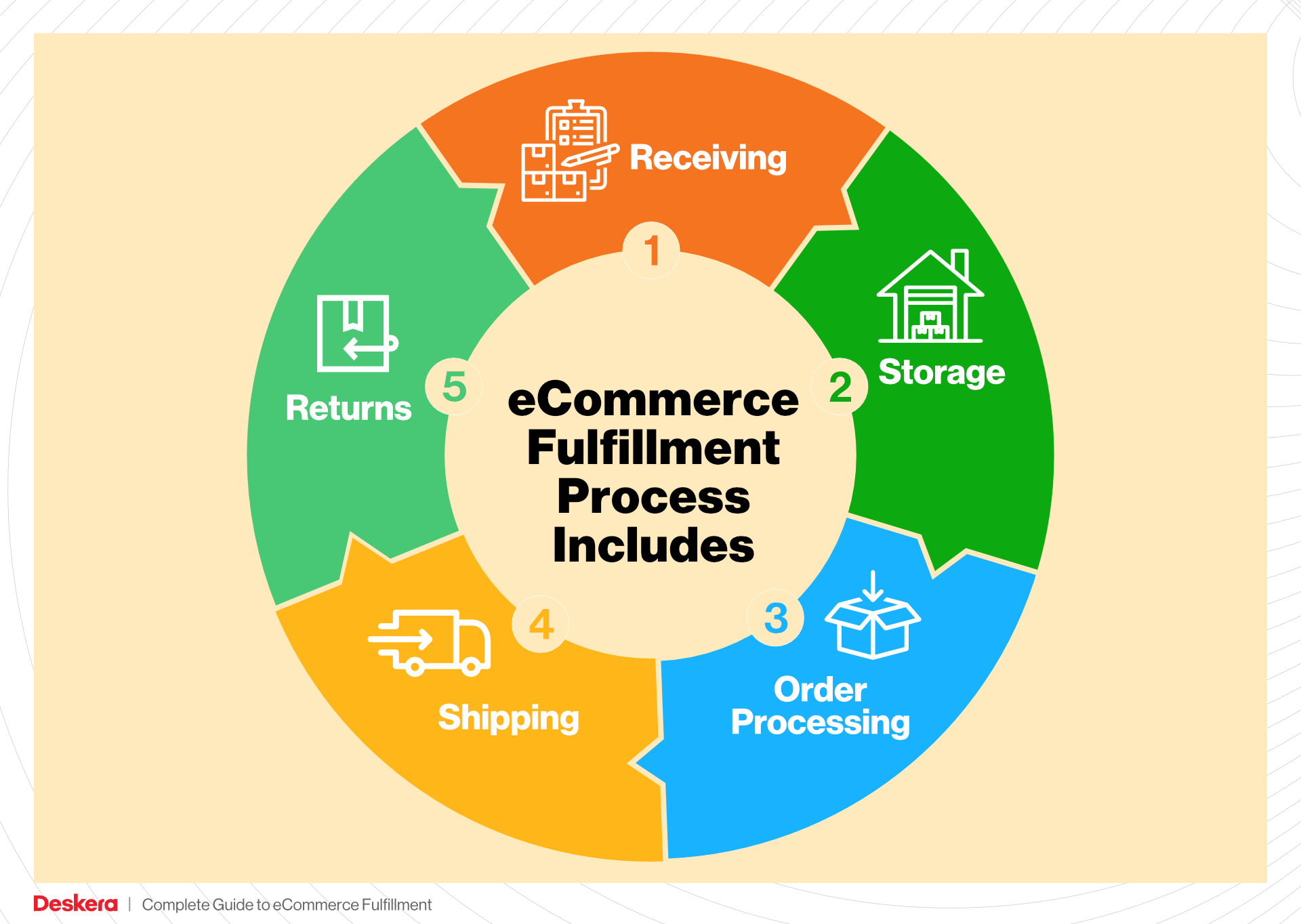
Lastly, we will discuss pricing strategies to help you understand the costs associated with different fulfillment options, enabling you to budget effectively and maintain profitability as you scale.
The ultimate goal of this guide is to empower you with the knowledge and tools needed to make strategic decisions about your logistics. By understanding e-commerce fulfillment, you can optimize your operations, reduce stress, and focus on what truly matters: growing your business and delighting your customers.
What You’ll Learn In This Guide
- What is E-commerce Fulfillment? An Introduction for Growing Businesses
- The Order Fulfillment Process: From ‘Buy’ Button to Customer’s Door
- Comparing Fulfillment Models: In-House vs. 3PL vs. Dropshipping
- A Deep Dive into Amazon FBA: Pros, Cons, and Who It’s For
- Core Services Offered by Fulfillment Centers
- How to Choose a Fulfillment Partner: A 6-Point Checklist
- Understanding Fulfillment Pricing: A Breakdown of Common Fees
- Frequently Asked Questions (FAQs) about Fulfillment
- Conclusion: Is Outsourcing Fulfillment the Right Move for Your Business?
- Important Disclaimer
The Order Fulfillment Process: From ‘Buy’ Button to Customer’s Door
1. Receiving Inventory
The order fulfillment process begins with receiving inventory at the fulfillment center. This step involves the acceptance of goods from suppliers or manufacturers, where items are verified against purchase orders to ensure accuracy. Key tasks include checking for damages, confirming quantities, and labeling items with unique identifiers like SKUs (Stock Keeping Units).
Importance: Proper inventory receiving is crucial as it lays the foundation for effective inventory management. Inaccuracies at this stage can lead to stock discrepancies, which may result in stockouts or overstock situations that can hinder sales and increase holding costs.
Key Term: SKU – This identifier helps track products efficiently throughout the fulfillment process, enabling better inventory management and order accuracy.
2. Warehouse Storage
Once the inventory is received and verified, it is stored in the fulfillment center. Effective warehouse storage involves strategically placing items in designated areas based on factors such as product size, weight, and frequency of order. This organization may include shelving, bins, or pallets to optimize space and facilitate quick access.
Importance: Efficient storage solutions minimize the time and effort required to retrieve products during the picking process. A well-organized warehouse leads to improved operational efficiency, reducing labor costs and increasing the speed of fulfillment.
Key Term: Slotting – This refers to the process of determining the best locations for products within the warehouse, which can significantly impact picking efficiency.
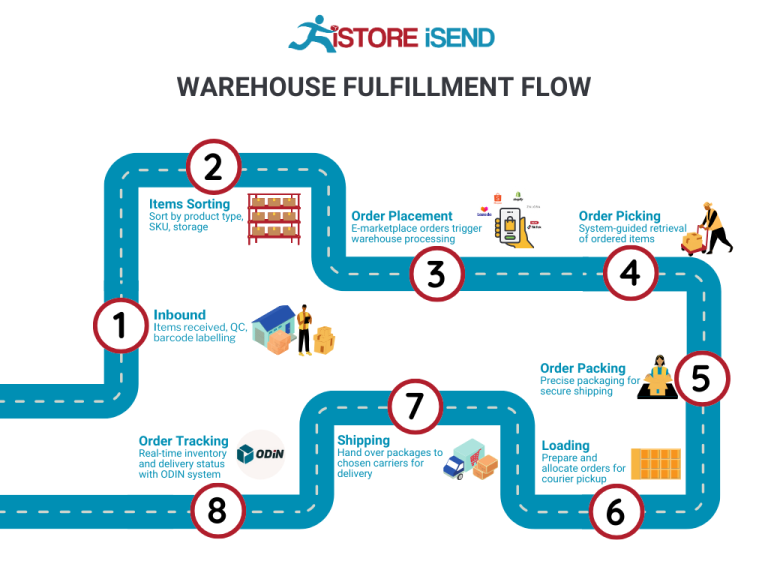
3. Order Picking
When a customer places an order, the next step is order picking. This involves gathering the selected items from their respective storage locations based on a pick list, which details the items ordered along with their locations in the warehouse. Workers or automated systems retrieve the products for packaging.
Importance: Order picking is a critical step that directly affects order accuracy and customer satisfaction. Errors during this stage can lead to incorrect shipments, resulting in returns, refunds, and a negative impact on the seller’s reputation.
Key Term: Pick List – A document or digital tool that guides pickers on which items to collect for an order, including quantities and locations within the warehouse.
4. Order Packing
After the items are picked, they are moved to the packing area where they are prepared for shipment. This step includes checking the items for quality, packing them securely in appropriate materials, and labeling the packages for delivery. Packaging considerations can include cushioning materials, box sizes, and branding elements.
Importance: Effective packing protects products during transit and ensures they arrive in perfect condition. It also presents an opportunity for branding, as well-packaged products enhance the unboxing experience for customers, potentially leading to repeat business.
Key Term: Packing Slip – A document included in the package that outlines the items contained within, serving both as a receipt for the customer and a checklist for the fulfillment center.
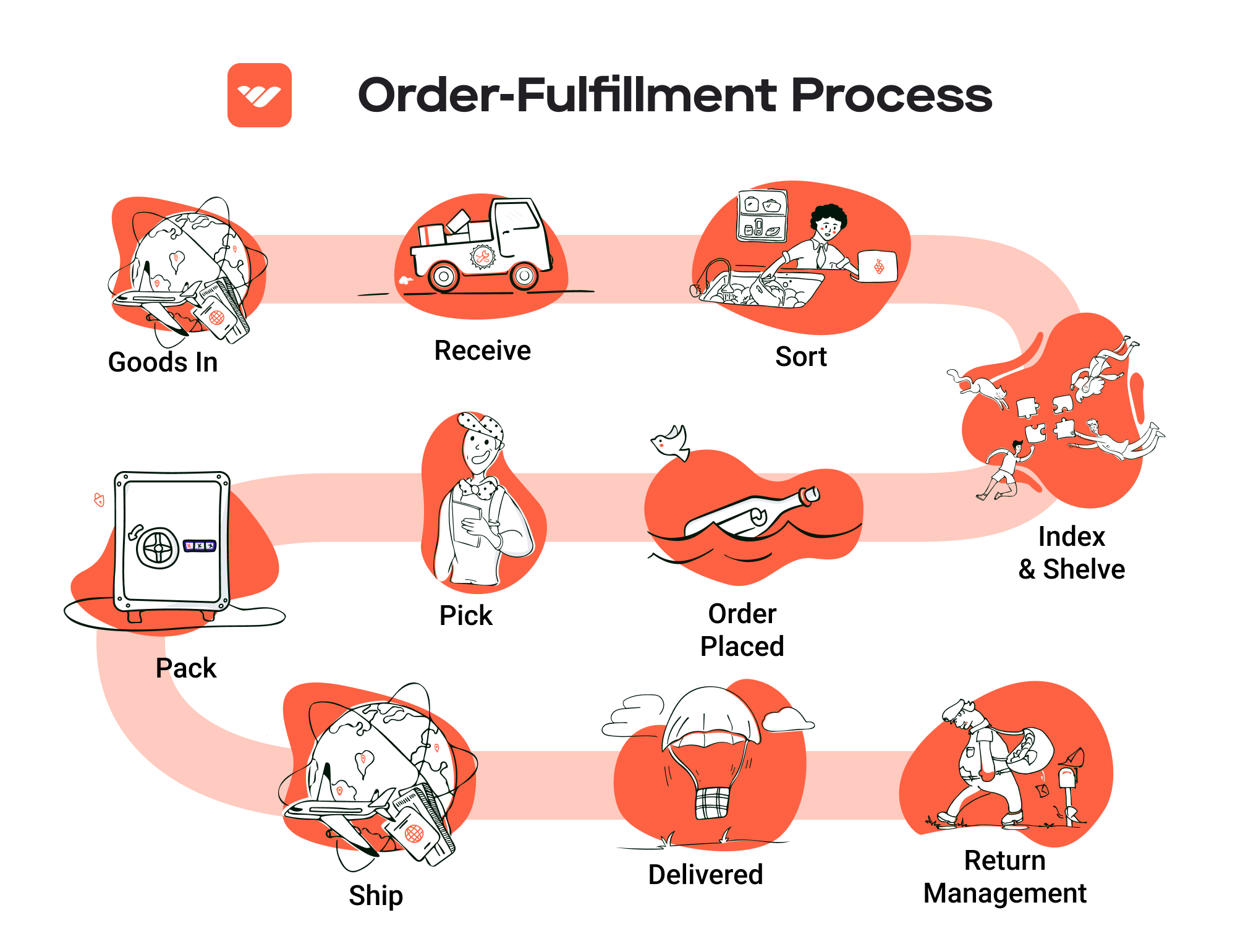
5. Shipping & Delivery
The final step in the order fulfillment process is shipping and delivery. Once packed, packages are prepared for dispatch to the customer. This involves selecting a shipping carrier, generating shipping labels, and scheduling pickups or drop-offs. Tracking information is often provided to customers to keep them informed about their order status.
Importance: Timely and accurate shipping is vital for customer satisfaction. Fast delivery times can differentiate a business in the competitive e-commerce landscape, enhancing the overall shopping experience and encouraging customer loyalty.
Key Term: Last Mile Delivery – This term refers to the final leg of the shipping process, where the package is delivered from a transportation hub to the customer’s door. It is often the most complex and costly part of the shipping process, making it a key area for optimization in fulfillment strategies.
By understanding and optimizing each step of the order fulfillment process, e-commerce businesses can enhance their operational efficiency, improve customer satisfaction, and ultimately drive sales growth.
Comparing Fulfillment Models: In-House vs. 3PL vs. Dropshipping
Fulfillment Model Comparison Table
| Model | Who Handles Inventory | Best For (Business Stage) | Key Advantage | Key Disadvantage |
|---|---|---|---|---|
| In-House Fulfillment | The business itself | Established businesses with stable sales | Complete control over the fulfillment process | High overhead costs and resource-intensive |
| Third-Party Logistics (3PL) | A third-party provider | Growing businesses looking to scale | Access to expertise and reduced operational burden | Less control over inventory and potential communication issues |
| Dropshipping | Supplier or manufacturer | Startups or businesses with limited capital | Low startup costs and minimal risk | Lower profit margins and reliance on supplier reliability |
In-House Fulfillment
In-house fulfillment refers to the process where a business manages its own inventory and order fulfillment operations. This model is ideal for established businesses that have consistent sales and can afford the necessary infrastructure and personnel. One of the key advantages of in-house fulfillment is that it offers complete control over the entire fulfillment process, from inventory management to order packaging and shipping. This level of control allows businesses to customize their operations, ensure quality standards, and respond swiftly to customer inquiries. However, the main disadvantage is the high overhead costs associated with maintaining a warehouse, staffing, and managing logistics. As a business scales, these costs can become a significant burden, especially if demand fluctuates.
Third-Party Logistics (3PL)
Third-party logistics (3PL) providers offer a solution where businesses outsource their fulfillment operations to an external company. This model is particularly beneficial for growing businesses that are looking to scale without the burden of managing logistics in-house. By partnering with a 3PL, companies gain access to specialized expertise, advanced technology, and a network of distribution centers, which can lead to faster shipping times and reduced costs. Additionally, 3PLs often provide services such as inventory management, order processing, and returns handling, allowing businesses to focus on their core competencies. However, this model also has its drawbacks. Businesses may experience less control over their inventory and fulfillment processes, which can lead to potential issues with communication and service quality. It’s crucial for businesses to choose a reliable 3PL partner to mitigate these risks.
Dropshipping
Dropshipping is a fulfillment model where the retailer does not keep products in stock but instead transfers customer orders and shipment details to a manufacturer or wholesaler, who then ships the goods directly to the customer. This model is particularly appealing for startups or businesses with limited capital, as it requires minimal upfront investment and reduces the financial risk associated with holding inventory. One of the primary advantages of dropshipping is the ability to offer a wide range of products without the need to invest in inventory. However, the key disadvantage is that dropshipping typically results in lower profit margins compared to other fulfillment methods. Furthermore, businesses relying on dropshipping must contend with the reliability of their suppliers, as delays or quality issues can directly impact customer satisfaction and brand reputation. As such, building strong relationships with dependable suppliers is essential for success in the dropshipping model.
Conclusion
Choosing the right fulfillment model is crucial for e-commerce businesses aiming to scale effectively. Each model—In-House Fulfillment, Third-Party Logistics (3PL), and Dropshipping—has its distinct advantages and disadvantages, making it essential for business owners to assess their current stage, resources, and long-term goals. By understanding the implications of each fulfillment method, businesses can make informed decisions that align with their operational capabilities and market demands.
A Deep Dive into Amazon FBA: Pros, Cons, and Who It’s For
What is Fulfillment by Amazon (FBA)?
Fulfillment by Amazon (FBA) is a logistics service offered by Amazon that allows e-commerce sellers to store their products in Amazon’s fulfillment centers. This service enables sellers to leverage Amazon’s extensive logistics network for storage, packaging, shipping, and customer service. When a customer places an order for a product listed under FBA, Amazon takes care of the entire fulfillment process, including picking, packing, and shipping the product directly to the customer.
FBA is particularly advantageous for businesses looking to scale their operations without the complexities of managing their own warehousing and shipping logistics. By utilizing FBA, sellers can focus on marketing, product development, and customer engagement while Amazon handles the operational aspects of order fulfillment.
How Does FBA Work?
-
Product Storage: Sellers send their products to Amazon’s fulfillment centers. Amazon manages the storage of these items in their warehouses, which are strategically located to optimize shipping times.
-
Order Fulfillment: When a customer orders a product, Amazon employees pick the item from the warehouse, pack it, and ship it directly to the customer.
-
Customer Service: Amazon also manages customer service and returns for FBA products, providing sellers with support to resolve issues quickly and maintain customer satisfaction.
-
Inventory Management: Sellers can monitor their inventory levels through the Amazon Seller Central dashboard, which provides insights into stock levels, sales trends, and performance metrics.
-
Multi-Channel Fulfillment: FBA can also be used to fulfill orders from other sales channels, such as Shopify or eBay, allowing sellers to centralize their logistics operations.
Pros of Fulfillment by Amazon (FBA)
-
Prime Eligibility: Products fulfilled by Amazon are eligible for Amazon Prime, which offers free two-day shipping to Prime members. This can significantly increase the visibility and attractiveness of products, leading to higher sales.
-
Customer Trust: Leveraging Amazon’s brand reputation can enhance customer trust. Shoppers are often more willing to purchase products that are fulfilled by Amazon due to their established customer service and return policies.
-
Multi-Channel Fulfillment: FBA allows sellers to fulfill orders from other platforms, enabling a unified inventory management system while expanding sales potential across multiple channels.
-
Scalability: FBA provides a scalable solution for growing businesses. As sales increase, sellers can send more inventory to Amazon’s warehouses without needing to invest in additional space or logistics management.
-
Time Savings: By outsourcing fulfillment to Amazon, sellers save time on order processing, shipping logistics, and customer service, allowing them to focus on other critical areas of their business.
Cons of Fulfillment by Amazon (FBA)
-
High Fees: While FBA offers many conveniences, it comes at a cost. Sellers are subject to various fees, including storage fees for inventory and fulfillment fees for each order shipped. These costs can add up, especially for lower-margin products.
-
Strict Inventory Rules: Amazon enforces strict guidelines regarding inventory management, including limits on storage space and requirements for labeling and packaging. Failure to comply can result in additional fees or even removal from the platform.
-
Commingling Risks: With FBA, products from different sellers may be stored together in the same location, a practice known as commingling. This can lead to issues where sellers may receive returns or negative feedback for products that were not originally theirs.
-
Loss of Control: By outsourcing fulfillment, sellers may feel a loss of control over the customer experience. While Amazon handles shipping and customer service, sellers may have limited visibility into these processes.
-
Seasonal Demand: During peak seasons, such as holidays, FBA can experience capacity limits, which may affect a seller’s ability to store inventory or fulfill orders on time.
Who is FBA Best For?
Fulfillment by Amazon is particularly well-suited for:
-
Small to Medium-Sized Sellers: E-commerce entrepreneurs looking to minimize overhead and streamline logistics can benefit significantly from FBA. It provides an efficient way to scale operations without the burden of managing fulfillment in-house.
-
Brands Seeking Visibility: Sellers who want to take advantage of Amazon’s vast customer base and brand trust will find FBA to be a powerful tool for gaining visibility and credibility.
-
Businesses with High Sales Volume: Companies that experience high sales volume, particularly in consumer goods, can leverage FBA’s efficiencies to reduce shipping times and improve customer satisfaction.
-
Multi-Channel Sellers: Brands selling across multiple platforms can centralize their fulfillment processes through FBA, making it easier to manage inventory and shipping.
In conclusion, while Fulfillment by Amazon offers a plethora of advantages for e-commerce sellers, it is essential to weigh these benefits against the potential downsides. Understanding the intricacies of FBA can help businesses make informed decisions about whether this fulfillment model aligns with their operational goals and customer service expectations.
Core Services Offered by Fulfillment Centers
Inventory Management & Warehousing
Inventory management is a critical component of any e-commerce operation, as it ensures that businesses maintain optimal stock levels, minimize holding costs, and prevent stockouts. Fulfillment centers excel in providing sophisticated inventory management systems that track stock in real-time. This involves monitoring inventory levels, managing reorders, and forecasting demand based on historical data and market trends.
The benefit of having a robust inventory management system in a fulfillment center is twofold. First, it reduces the risk of overstocking or understocking, both of which can significantly impact cash flow and customer satisfaction. Overstocking leads to increased storage costs and potential markdowns, while understocking can result in lost sales and dissatisfied customers. Second, effective inventory management allows e-commerce businesses to streamline their operations, ensuring that products are readily available for quick shipping, thereby enhancing the customer experience.
Pick and Pack Services
Pick and pack services are at the heart of the fulfillment process. This service involves selecting items from inventory (picking) and then packaging them for shipment (packing). Fulfillment centers employ advanced warehouse management systems and trained personnel to efficiently pick items based on customer orders, ensuring accuracy and speed.
The primary advantage of utilizing pick and pack services is the efficiency it brings to order fulfillment. By outsourcing this function to a fulfillment center, e-commerce businesses can save valuable time and resources, allowing them to focus on growth and customer engagement. Additionally, fulfillment centers often have optimized processes that reduce errors in order fulfillment, leading to higher customer satisfaction rates. Fast and accurate shipping is a competitive edge in the e-commerce landscape, and effective pick and pack services are essential for achieving this.
Kitting and Assembly
Kitting and assembly services involve grouping multiple products into a single package or kit, which can be especially useful for businesses that sell subscription boxes, gift sets, or promotional bundles. Fulfillment centers can handle the assembly of these kits, ensuring that all components are included and packaged attractively.
The benefits of kitting and assembly services are significant. First, they allow e-commerce businesses to offer unique products that can differentiate them from competitors. By creating bundled offers, businesses can encourage higher average order values and enhance customer satisfaction through convenience. Second, kitting services can streamline the fulfillment process, as products are pre-packaged and ready for shipping, reducing handling time during peak periods. This efficiency can lead to faster delivery times, which is increasingly important in today’s fast-paced e-commerce environment.
Returns Management (Reverse Logistics)
Returns management, often referred to as reverse logistics, is a crucial service offered by fulfillment centers that deals with the process of handling returned products. This includes receiving, inspecting, sorting, and restocking or disposing of returned items. A well-managed returns process is vital for maintaining customer satisfaction and loyalty.
The importance of effective returns management cannot be overstated. A streamlined returns process enhances the customer experience by making it easy for customers to return items, thereby building trust and encouraging repeat business. Moreover, fulfillment centers can analyze return data to identify patterns or issues with specific products, allowing e-commerce businesses to make informed decisions about inventory and product offerings. By managing returns efficiently, businesses can minimize losses associated with returned goods and improve their overall profitability.
In conclusion, partnering with a fulfillment center offers e-commerce businesses a suite of core services that are essential for scaling operations effectively. From inventory management and warehousing to pick and pack services, kitting, and returns management, these services not only enhance operational efficiency but also improve customer satisfaction and drive growth. By leveraging the expertise and resources of fulfillment centers, businesses can focus on their core competencies while ensuring that their logistics operations run smoothly and effectively.
How to Choose a Fulfillment Partner: A 6-Point Checklist
Location & Warehouse Network
The geographical location of your fulfillment partner is critical for optimizing shipping times and costs. A partner with a well-distributed warehouse network can ensure faster delivery to your customers, which is increasingly important in today’s e-commerce landscape.
Key Questions to Ask:
– Where are your warehouses located, and how does that impact shipping times to my primary customer base?
– Do you have multiple locations to support national or international shipping?
– What is your average shipping time for orders from each warehouse?
Technology & Integrations
The technology stack of your fulfillment partner can greatly influence your operational efficiency. A robust Warehouse Management System (WMS) should seamlessly integrate with your existing e-commerce platforms and provide real-time inventory tracking, order management, and reporting capabilities.
Key Questions to Ask:
– What technology do you use for inventory management and order processing?
– Can your systems integrate with my existing e-commerce platforms (like Shopify, WooCommerce, etc.)?
– How do you handle inventory visibility and reporting? Can I access real-time data?
Specializations (e.g., Cold Storage, Oversized Items)
Different businesses have unique requirements, and some fulfillment centers specialize in specific types of products or services. Whether you need cold storage for perishable goods or the capability to manage oversized items, selecting a partner with the right specialization can enhance your logistics efficiency.
Key Questions to Ask:
– What types of products do you specialize in handling?
– Do you have facilities that can accommodate unique requirements, such as temperature-controlled storage or oversized items?
– Can you provide examples of clients in my industry or with similar needs?
Scalability & Capacity
As your business grows, your fulfillment needs will evolve. It’s essential to choose a partner that can scale operations up or down based on your sales fluctuations. A partner with sufficient capacity can also help you avoid stockouts or delays during peak seasons.
Key Questions to Ask:
– How do you handle seasonal spikes in order volume?
– What is your current capacity, and how quickly can you scale operations if my business grows?
– Are there additional fees for scaling up services during peak periods?
Pricing and Contracts
Understanding the pricing structure and contract terms is fundamental to maintaining a sustainable profit margin. Look for transparency in pricing models, including hidden fees for services like returns, storage, or handling.
Key Questions to Ask:
– Can you provide a detailed breakdown of your pricing structure?
– What are the terms regarding long-term contracts? Are there any penalties for early termination?
– Are there additional costs for services like returns processing or special handling?
Customer Support & Reviews
Effective customer support is crucial for resolving issues quickly and ensuring smooth operations. Additionally, researching customer reviews can provide insights into the partner’s reliability and service quality.
Key Questions to Ask:
– What customer support options do you offer (e.g., phone, email, chat)?
– What are your average response times for customer inquiries or issues?
– Can you share customer testimonials or case studies that demonstrate your service reliability?
In conclusion, choosing the right fulfillment partner is a pivotal decision that can significantly impact your e-commerce business’s efficiency and customer satisfaction. By using this checklist, you can systematically evaluate potential partners and ensure that they align with your operational needs and growth goals. Remember, a strong fulfillment partner not only supports your logistics but can also enhance your overall business strategy.
Understanding Fulfillment Pricing: A Breakdown of Common Fees
Initial Setup Fees
Initial setup fees are typically charged when you first engage a fulfillment service. These fees cover the costs associated with onboarding your business into the fulfillment center’s system. This may include creating your account, integrating your e-commerce platform with their warehouse management system (WMS), and configuring any necessary software tools.
The calculation of initial setup fees varies by provider but can range from a flat fee to a percentage of your first order volume. Some fulfillment centers may waive these fees to attract new clients, so it’s essential to inquire about any promotional offers that could reduce your initial costs.
Receiving Fees
Receiving fees apply when your inventory arrives at the fulfillment center. These fees cover the labor and resources required to unload, inspect, and enter your products into the inventory system.
Receiving fees are generally calculated based on the volume of goods received, often measured in weight or the number of pallets. For example, you might pay a fixed fee per pallet or per 100 pounds of product. It’s important to clarify whether these fees include product inspection and labeling, as additional services may incur extra charges.
Storage Fees (per pallet/bin)
Storage fees are charged for the space your inventory occupies in the fulfillment center. This is often calculated on a monthly basis and can be based on the number of pallets or bins used.
Most fulfillment centers use a tiered pricing model, where the cost per pallet decreases as you store more pallets. For instance, the first 10 pallets may incur a higher rate than pallets 11-20. Additionally, storage fees can vary by season; during peak times (like the holiday season), fees may be higher due to increased demand for warehouse space. Understanding these seasonal fluctuations is crucial for budgeting.
Pick & Pack Fees (per item/order)
Pick and pack fees are charged for the labor involved in selecting items from your inventory and preparing them for shipment. This typically involves picking items off the shelves, packing them into boxes, and labeling them for delivery.
These fees are usually calculated on a per-item basis, meaning you will pay a fee for each item picked and packed. Some fulfillment centers may offer tiered pricing based on the order volume—where larger orders receive a discount on the per-item fee. Additionally, if your products require special packing materials or handling, expect to pay extra for those services.
Shipping Fees
Shipping fees cover the cost of transporting your products from the fulfillment center to your customers. These fees are influenced by several factors, including the shipping method (standard, expedited, etc.), the destination (domestic or international), and the weight and dimensions of the package.
Most fulfillment centers partner with multiple carriers to offer competitive shipping rates. They may provide options for you to choose from, allowing you to balance cost and delivery speed. Shipping fees are typically calculated based on the shipping service selected and the total weight of the shipment. Keep in mind that additional charges may apply for fragile items or special delivery requirements.
Tips for Getting an Accurate Quote
-
Provide Detailed Information: When requesting quotes from fulfillment centers, be as detailed as possible about your product types, order volumes, and specific requirements. This helps providers give you a more accurate estimate.
-
Understand All Potential Fees: Ask for a comprehensive breakdown of all potential fees, including those that may be less obvious, such as returns processing or seasonal surcharges.
-
Consider Your Growth Plans: If you plan to scale your business, discuss how fees may change as your order volume increases. Some fulfillment centers offer incentives for larger volumes.
-
Negotiate Terms: Don’t hesitate to negotiate terms and fees, especially if you are considering multiple providers. Some may be willing to offer discounts or more favorable terms to secure your business.
-
Request Sample Calculations: Ask the fulfillment center for sample calculations based on your projected order volume. This can help you understand how different fees might impact your overall costs.
By understanding these common fulfillment pricing models and following these tips, you can make informed decisions that align with your business goals and budget, ensuring a smooth and cost-effective fulfillment process as you scale.
Frequently Asked Questions (FAQs) about Fulfillment
1. How do I contact an Amazon Fulfillment Center?
To contact an Amazon Fulfillment Center, you can use the Amazon Seller Central portal if you are an Amazon seller. For general inquiries, locate the specific fulfillment center’s phone number or email from the Amazon website or the contact information provided in your seller account. Each fulfillment center may have different contact details, so it is essential to refer to the specific center you wish to reach.
2. What is the difference between a warehouse and a fulfillment center?
A warehouse primarily serves as a storage space for inventory, while a fulfillment center is designed to handle the entire order fulfillment process. Fulfillment centers manage inventory storage, pick and pack orders, and ship products directly to customers, often providing additional services like customer service and returns processing. In contrast, warehouses typically focus on long-term storage without the added logistics services.
3. What is a 3PL?
A 3PL, or third-party logistics provider, is a company that offers outsourced logistics services, including warehousing, fulfillment, and transportation. Businesses often partner with 3PLs to improve efficiency, reduce costs, and scale operations without needing to manage the logistics in-house. Fulfillment centers can be considered a type of 3PL, specifically focused on order fulfillment.
4. How much do fulfillment services cost?
The cost of fulfillment services varies based on several factors, including the volume of orders, types of services required (such as storage, packing, and shipping), and specific provider pricing structures. Generally, fulfillment fees can include a per-order fee, storage fees based on the amount of inventory held, and shipping costs. It’s best to request quotes from multiple providers to compare pricing and find the best solution for your business.
5. Can I use multiple fulfillment centers?
Yes, using multiple fulfillment centers can be a strategic move for your business, especially if you are selling across different regions. This approach can reduce shipping times, lower costs, and improve customer satisfaction by ensuring quicker delivery. However, it requires effective inventory management to avoid stock discrepancies across locations.
6. How do I choose the right fulfillment center?
Choosing the right fulfillment center involves evaluating several factors, including location, service offerings, technology capabilities, scalability, and pricing. Consider your specific business needs, such as order volume, product type, and shipping requirements. Conducting a thorough assessment of potential partners and requesting demos or trials can help you make an informed decision.
7. What services do Amazon Fulfillment Centers offer?
Amazon Fulfillment Centers provide a range of services, including inventory storage, order processing, picking and packing, shipping, returns handling, and customer service. Additionally, they offer features like FBA (Fulfillment by Amazon) that integrate seamlessly with your Amazon seller account, providing an end-to-end solution for e-commerce businesses.
8. What is the role of inventory management in fulfillment?
Inventory management is crucial in fulfillment as it ensures that products are available when customers place orders, preventing stockouts and overstock situations. Effective inventory management systems help track inventory levels, forecast demand, and manage reordering processes, which is essential for maintaining a smooth fulfillment operation and maximizing customer satisfaction.
9. How can I improve my fulfillment process?
To improve your fulfillment process, consider adopting advanced technologies such as warehouse management systems (WMS) that streamline operations. Optimize your inventory levels to ensure you have the right products on hand, and evaluate your shipping options to find the most cost-effective solutions. Regularly review performance metrics to identify bottlenecks and areas for improvement.
10. What should I do if I have issues with my fulfillment center?
If you encounter issues with your fulfillment center, first, reach out to your account manager or customer service representative to discuss your concerns. Provide detailed information about the problem, such as missed shipments or inventory discrepancies. If the issues persist, consider evaluating alternative fulfillment partners to ensure your business needs are met effectively.
Conclusion: Is Outsourcing Fulfillment the Right Move for Your Business?
Evaluating the Benefits of Outsourcing Fulfillment
Outsourcing fulfillment can be a game-changer for e-commerce businesses looking to scale efficiently. By leveraging a third-party logistics (3PL) provider, you can save valuable time and resources, allowing you to focus on core business functions like marketing and product development. Fulfillment services handle inventory management, order processing, and shipping logistics, reducing the burden on your internal team and enabling faster response times to customer demands.
Scalability is another significant advantage. As your business grows, so do your logistics needs. A reliable fulfillment partner can provide the infrastructure and flexibility to manage increased order volumes without the need for substantial capital investment in warehousing and staffing. This adaptability is crucial for navigating seasonal fluctuations or unexpected spikes in demand.
Moreover, partnering with a fulfillment service brings expertise that can enhance your operational efficiency. These providers often utilize advanced technology and best practices in inventory management, shipping, and customer service, which can lead to improved accuracy, reduced shipping times, and better overall customer satisfaction. This level of professionalism can be difficult to replicate in-house, particularly for smaller businesses with limited resources.
Choosing the Right Partner for Growth
However, not all fulfillment partners are created equal. It’s essential to conduct thorough due diligence when selecting a provider to ensure they align with your business goals and can support your growth trajectory. Look for partners with a proven track record, transparent pricing, and robust support systems.
Next Steps: Audit Your Current Shipping Process
As you consider the potential benefits of outsourcing fulfillment, take a moment to audit your current shipping and logistics processes. Assess whether your existing operations can scale effectively or if a fulfillment partner could provide the strategic advantage you need. By making an informed decision, you can position your business for sustainable growth and enhanced customer satisfaction.
Important Disclaimer
⚠️ Important Disclaimer
The information in this guide is for educational purposes. Fulfillment services, pricing, and platform features change frequently. Always conduct your own due diligence and consult with providers directly before making business decisions.
